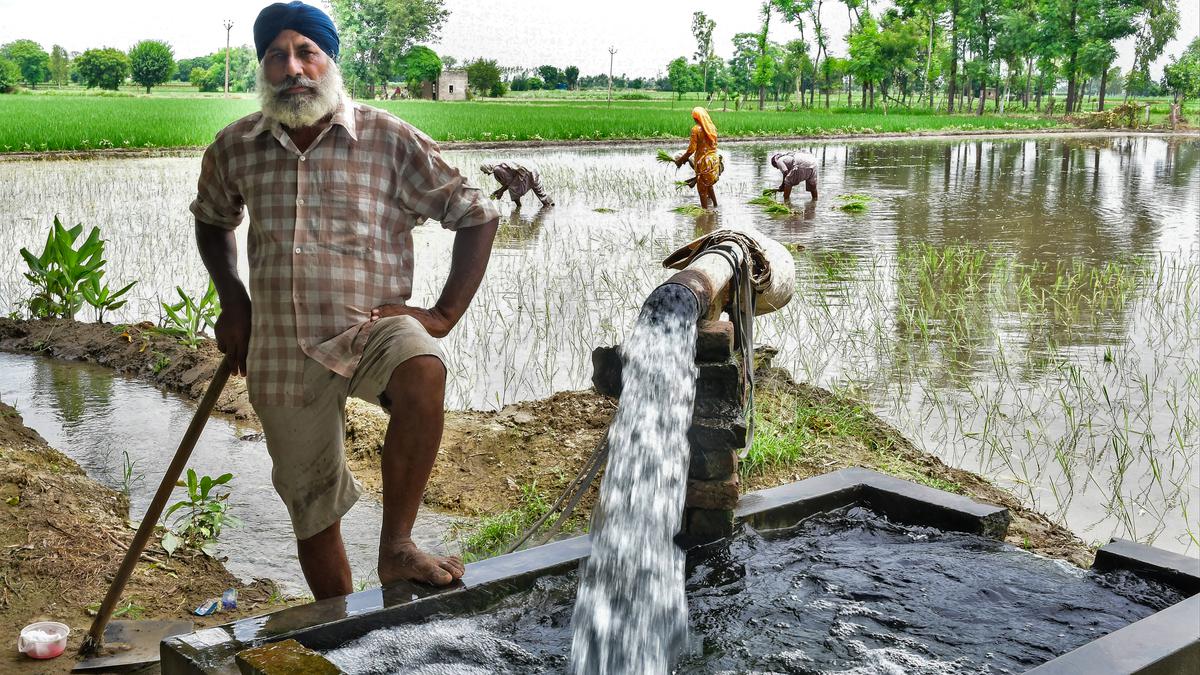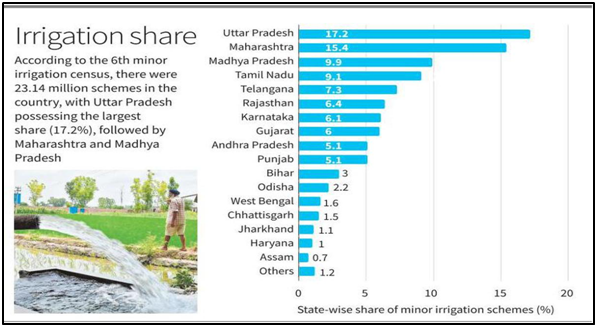What’s in Today’s Article?
- Why in News?
- What are the Minor Irrigation Schemes?
- About the Minor Irrigation Census (MIC)
- Findings of the Sixth MIC
Why in News?
- The latest/sixth edition of the Minor Irrigation Census (MIC) finds that electricity is the dominant source (3/4th) of power to extract water, over diesel, windmills, and solar pumps.
- The MIC is a compendium of borewells, tubewells, and other privately owned irrigation sources by farmers.
What are the Minor Irrigation Schemes?
- Non-irrigated (rain-fed) agriculture depends entirely on rainfall, stored in the soil profile.
- Irrigation provides a powerful management tool against the vagaries of rainfall (which is not uniform across the country) and makes it economically attractive –
- To grow high yield seed varieties and
- To apply adequate plant nutrition as well as pest control and other inputs, thus giving room for a boost in yields.
- Minor Irrigation schemes contribute a major share in the growing irrigation across the country.
- Irrigation schemes using either groundwater or surface water and having a Culturable Command Area up to 2000 hectares individually are categorized as Minor Irrigation Schemes.
- Minor Irrigation plays an important role in the development of agriculture and livelihoods particularly in drought prone areas and areas outside command of Major and Medium projects.
- The schemes have been categorised broadly into 6 major types:
- Dugwell (can draw water from a maximum depth of 15 metres),
- Shallow tubewell (capable of drawing water from up to 35 metres),
- Medium Tubewell (up to 70 metres),
- Deep tubewell (beyond 70 metres),
- Surface flow schemes and
- Surface lift schemes.
About the Minor Irrigation Census (MIC):
- The need for conducting the census of Minor Irrigation arose as it was felt that a database of these schemes will serve the planning, development and management needs of these schemes which contribute to agriculture in a big way.
- The First Census of Minor Irrigation schemes was conducted with reference year 1986-87.
- This is the Sixth MIC, which has been conducted with reference year 2017-18 in all States and UTs except Delhi, Daman & Diu, Dadra and Nagar Haveli and Lakshadweep.
- This means the MIC reports aren’t a reflection of the present state of use.
- Because data collection requires collecting granular data down to the block level, it takes a few years to compile and make the data public.
- The First census of water bodies has also been taken up in convergence with the sixth MIC.
Findings of the Sixth MIC:
- The number of MI schemes:
- Overall, 23.14 million MI schemes were reported in the country from 695 districts, which shows an increase of about 1.42 million between the fifth and sixth editions.
- Most of the schemes (96.6%) were privately owned and small and marginal farmers, having less than two hectares of land, owned the majority of MI schemes.
- Out of all MI schemes, 21.93 million (94.8%) were for groundwater (GW) and 1.21 million (5.2%) for surface-water (SW) extraction.
- UP had the largest number of MI schemes in the country (17.2%) followed by Maharashtra (15.4%) and MP (9.9%).
- Leading States in GW schemes are UP, Maharashtra, MP; whereas Maharashtra, Karnataka, Telangana, Odisha and Jharkhand have the highest share in SW schemes.
- The use of electricity: While it showed a quantum jump from powering only 56% of sources in 2011 to 70% in 2017, the latest report shows electricity as powering 76% of sources – a slower growth rate.
- This electrification of groundwater withdrawal corresponds to a rise in the use of tube wells and borewells that are capable of extracting water at greater depths.
- Dominant source of groundwater:
- While ‘dug-wells’ or ponds remain the dominant source of groundwater, their number has declined from 87 lakh to 82 lakh between the 5th and 6th editions.
- ‘Shallow’ tube wells have declined from 59 lakh to 55 lakh.
- However, ‘medium-sized’ wells grew from 31 lakh to 43 lakh and ‘deep’ wells rose from 26 lakh to 37 lakh.
- Causes for the increase of more powerful and deep-reaching tubewells:
- While excessive groundwater withdrawal has been a matter of long-standing concern, the report doesn’t discuss the causes for such increase.
- State governments announce schemes where farmers are incentivised or get access to loans to buy such tubewells, could be an explanation.
- However, the lower growth in electrification is also likely to be a result of greater emphasis on energy efficient water extraction.
Q1) What exactly is Mission Kakatiya?
Mission Kakatiya is a flagship program of the Telangana government that intends to revitalise water tanks and other water storage structures in order to support and help the state’s small and marginal farmers.
Q2) What is the Per Drop More Crop scheme?
The Per Drop More Crop scheme was launched by the government of India in 2015-16 to increase water use efficiency at the farm level through Micro Irrigation technologies like drip and sprinkler irrigation systems.
Source: Three-fourths of India’s irrigation sources run on electricity: study | MICENSUS
Last updated on June, 2025
→ UPSC Notification 2025 was released on 22nd January 2025.
→ UPSC Prelims Result 2025 is out now for the CSE held on 25 May 2025.
→ UPSC Prelims Question Paper 2025 and Unofficial Prelims Answer Key 2025 are available now.
→ UPSC Calendar 2026 is released on 15th May, 2025.
→ The UPSC Vacancy 2025 were released 1129, out of which 979 were for UPSC CSE and remaining 150 are for UPSC IFoS.
→ UPSC Mains 2025 will be conducted on 22nd August 2025.
→ UPSC Prelims 2026 will be conducted on 24th May, 2026 & UPSC Mains 2026 will be conducted on 21st August 2026.
→ The UPSC Selection Process is of 3 stages-Prelims, Mains and Interview.
→ UPSC Result 2024 is released with latest UPSC Marksheet 2024. Check Now!
→ UPSC Toppers List 2024 is released now. Shakti Dubey is UPSC AIR 1 2024 Topper.
→ Also check Best IAS Coaching in Delhi
























